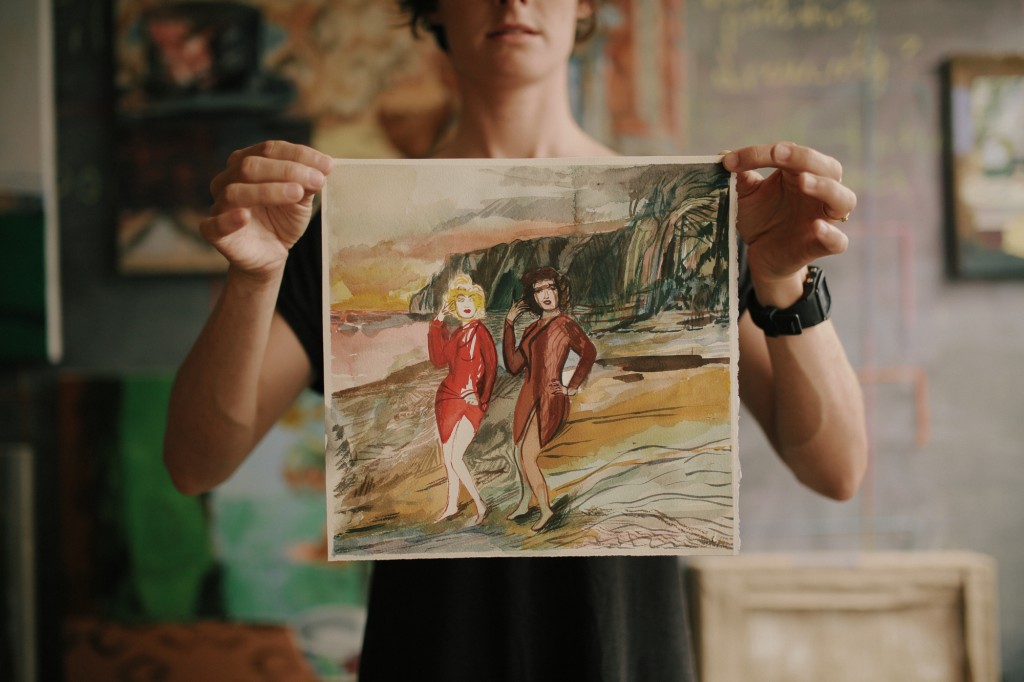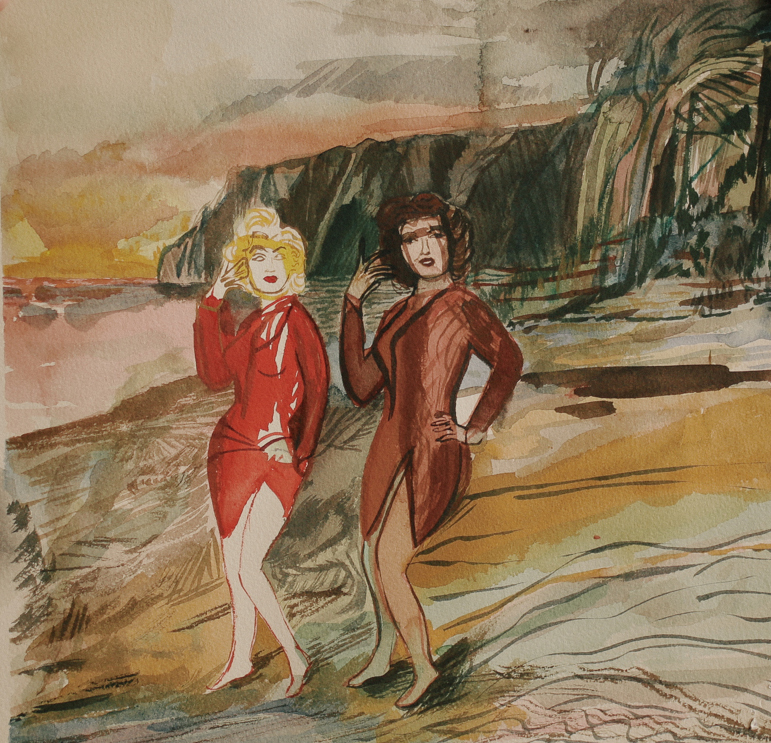Sand Dance
Happy National Poetry Month from Stance on Dance!
POETRY AND ARTWORK BY HADLEY NUNES; PHOTO BY VINCENT RICAFORT
Let’s see, where did I leave off? It was the hearing, well that and a whole host of issues. I found Merwin. He saved me. The poem I memorized is as follows:
All the day the stars watch from long ago
my mother said I’m going now
when you are alone you’ll be alright
whether or not you know you will know
look at the old house in the dawn rain
all the flowers are forms of water
the sun reminds them through a white cloud
touches the patchwork spread on the hill
the washed colors of the afterlife
that lived there long before you were born
see how they rise without a question
even though the whole world is burning
I met with Jorge, I danced and I went up north to the country. At the beach where I often go there were few people. Two young guys in fins and snorkel looked like they knew each other but they returned to opposite sides of the beach with their girlfriends after they got out of the water. One came back bearing gifts of shells he had found in the surf. I realized there must be many new shells with the winter swell moving all the water and sand around.
I looked at them together and he kissed her twice. He was a big guy with lots of tattoos and he was friendly when I told them how sweet they were. They were, you see.
I wanted to dance, so I did. I started with a tune to get things going. At first it was very difficult, the way I’ve been dancing on the marley at the studio and turns so much a part of the flow of getting from one position to another. I found a way to start from B+ and then do a rond de jambe from back to front to back and then a right foot front left foot front to set up the whole move at B+ again then I found out how to take the steps forward that would begin the third repetition and step to the right to pull back in a lunge 4th position with a port de bra back. By pulling up the whole position to standing with my left shoulder and arm swinging to port de bra, I could transition to start the entire sequence again. The pattern it made on the beach was precise and elliptical.
There was a score to it, a kind of jazzy sound that kept it all together.
After a while of doing this over and over, I let the sound go. Soon I let the dance go too. I was moving now inside the sand, my toes reached into the pockets my feet formed – they’d grab on and coordinate with each other to distribute my weight and keep balance. There were ways to push and ways to pull and my upper body was free to move so long as my core was stable and activated, and furthermore it helped if I could imagine where the next position would land. By picturing it in my mind in advance, I could get there with a greater certainty to keep the dance flowing. Doing and thinking one step ahead made for an interesting tension.
After a while I lost interest and when I brought back the singing I could focus again. People passed by, and although I’d say I did a pretty good job remaining focused on myself, it does change things and that relationship took me a few degrees away from the concentration I was able to have when I was mostly alone.
The song and the moves I had set helped keep me going and then when they would fade I could go back into the improvisation. I began to hear the sound of the ocean and its patterns and wondered if they could fit into a regular score of music. This was very interesting and led to a discovery I could never have imagined in advance.
I found it by watching the ocean, seeing the flow of the water and the waves break and the different kinds of speed. The reflection of the water on the saturated sand sucking down the slope was much slower than the waves receding. This pace gave me a meter to move to that was gradual, working with my feet and balance in the sand. The sudden faster movements that caught a flow of the water and speed of the waves would be a sudden burst very much dependent on where my body would land from position to position before it happened.
This dance with the patterns of the water – their irregular rhythm and speed – led me to read the other elements, wind in particular. This was another place where the expression of nature could shape and inspire my movement.
With a coordination that incorporated the sun, Naupaka plants and ironwood trees, I found there was a song, a score in motion, unpredictable, that, when observed, led to the most interesting movements and patterns and I was delighted and found the absorption that satisfied my motivation to continue.
How to end was a concern: with the score in continuance, how could I exit? Where and when would a completion to my activity arrive?
To thank each part of the score seemed perfectly natural; I was in a spiritual relationship and coordinating that to acknowledge what had given me the capacity to move without thought but through observation was miraculous, in fact, even though it was also perfectly normal and completely direct.
I started with a gesture towards the ocean, when I realized I could bring my knees down and move from each leg and back and turn toward the next direction and spiral I could flow in a concentrated way from the ground to my feet and out with my upper body. The comfort of the sand and how it embraced and took shape around my body gave me a healthy approach to weight shift and extension.
The water would come up and envelope me which was also fascinating and influenced my movements and the sensation of my legs as roots. The water reached toward me, a force whose direction reinforced the connection, the life force of union. Then it was the wind and flowing with air as it glided onto the surface and moved. Each time I repeated an arm movement that echoed the circular line my feet drew on the sand during my choreographed section earlier. From a seated position on my knees I could get the maximum reach of this gesture.
The trees, sky, sand and sun continued in this manner, each acknowledged separately although they flowed as one, each in coordination with each other. The sun scientifically the cause of these movements, as it created the waves of wind and the wind to wave and the wind moving the trees and the warmth to make the plants.
The spiritual connection I was experiencing is the most difficult part to articulate in a grounded way, which was central to the dance.
I thought I’d introduce metaphor now to help me and then I remembered when Peter said the use of metaphor is not the only way to be a poet. It was when we saw the photograph of wheat in a field by Eugène Atget. Nothing but the image itself, breathtaking, natural, pure and radiant, he said.
When I saw the occurrence of sound and coordination, circular to each element, I became one, the beauty of the union elevated my spirit and gave me access to the sensation and visual capacity of my human experience. Light and lifting, complete release and suspension was a form of the highest beauty I could access in that moment, my breath and body gave me transcendence in total relationship to my physicality.
I’ve got to do this again. The question of being seen and giving this level of my own personal experience is going to be in relation to the observer, for it is the observer observing me and my observation. To build a structure around that dynamic is possible, but I can’t reconcile the translation yet.
Hadley Nunes is an artist and founder of an international artist residency in Honolulu Hawai‘i called Present Project. She is also a founding member of Lana Lane Studios, an artist collective and studio project based in the neighborhood of Kaka‘ako in Honolulu. She has been exhibited at the Honolulu Museum of Art, Linekona Arts Center, I‘olani Palace, The William Louis Dreyfus Foundation, and The New York Studio School of Drawing, Painting & Sculpture. She has participated in residencies at The Virginia Center for Creative Arts, The Vermont Studio Center, The Elizabeth Foundation for the Arts and Watermill Center. For more info visit www.hadleynunes.com.



One Response to “Sand Dance”
Very very cool, in the Merwin spirit, like the tip of a brush on a canvas, or a dancer exiting the stage, or water plummeting within a green Ko’olau couloir, one long thread foaming, but silently, at a distance…
Comments are closed.